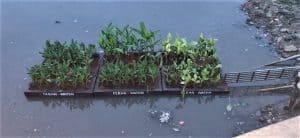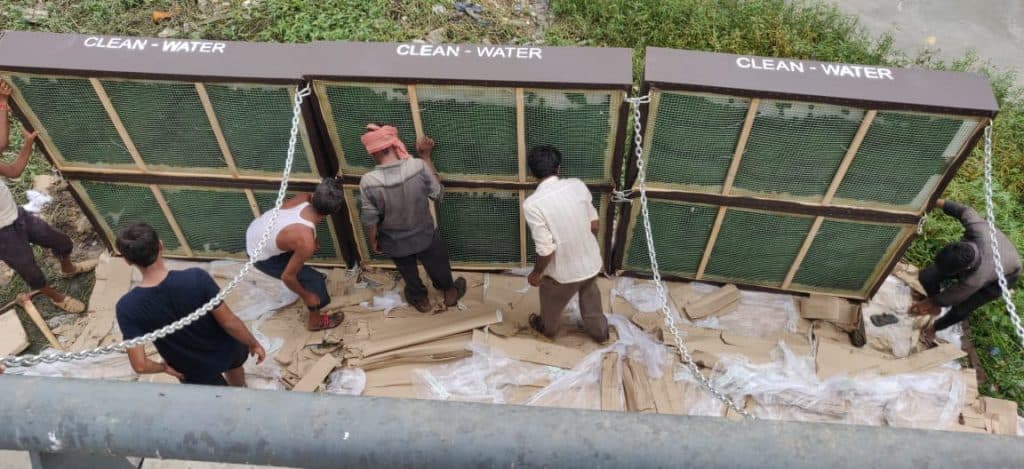Rapid urbanisation in India has claimed one major casualty – destruction of existing green cover in cities to make way for development and other projects. But with the growing realisation that a good quality of life means not just conserving, but also adding to the city’s green cover, and citizens pushing for the same, urban authorities in Ahmedabad, as in some other cities, are experimenting with ways of creating small green areas in an ever-expanding concrete urban landscape.
One method, much touted of late, is that of Miyawaki forests. Developed by Japanese botanist and plant ecologist Akira Miyawaki, and named after him, the Miyawaki method of reforestation is a way of ecological engineering that advocates development of forests even in small areas, by first treating the top layer of soil, and then planting local species that can flourish on their own. The municipal corporation of Ahmedabad — that has Kobe, Japan as a sister city — and the city’s builders are experimenting with this and are hoping to create such green spaces not only on land but also on the now fully flowing Sabarmati River.
“We chose this fast growing urban forestry method, which has a reported 15% faster growth rate per year compared to other reforestation methods,” said Dr Asif Memon, General Manager (Parks and Garden), Sabarmati River Development Front, who is overseeing the reforestation initiatives. “Moreover, for maintenance, all that a Miyawaki forest requires is good water supply and weeding for two years. Thereafter, it will be self-sustaining, needing no external support”.
Recently, about 67,000 trees were planted along the banks of Sabarmati, to ensure greening of areas along the waterfront, with the biggest patch encompassing 50,000 trees over an area of 10000 square meters on the west bank and Ambedkar bridge, and 17,000 trees in four other patches near Vallabhsadan, Gandhi bridge in the West and near Gayatri Mandir in the east.
Around 40 different indigenous tree species, including Drumstick, Mahuda, Jamun, Aamla, Mulberry, Kanjo, Kaju, Flame of the Forest, Sesam, Shami, Neem, Ramfal, Cordia species have been planted along with exotic varieties such as Cassia species, Paltoforam, Gulmohar, Spathodia, Largestonia, Saptparni, Chini badam, and Rain tree.
The exotic species selected are ones that have been flourishing for a long time in Ahmedabad.
How the plantation is done
Different species, based on their growth, fruit bearing and flowering patterns, were selected to grow side by side, for optimum use of soil nutrients and sunshine. Five different species were planted over an area measuring one square metre. The choice of species was based on their properties:
Which nutrients does each of them absorb from the soil?
Which nutrients do they give back?
Which species grows vertically and which develops a canopy? How long does it take for each to grow?
Understanding these patterns is the key to successful plantation, so that the forest develops at different levels, vertically and with adequate canopy. For example, species like Asopalav grow vertically, Amla has less canopy, while neem has more canopy, and Garmalo is a slow grower, with less canopy, and Aduso is fast growing, but has medium canopy.
“We had checked the soil profile and realised that it was filling soil, consisting mostly of debris and yellow soil (murrum) which must have been dumped here as landfills,” said Asif Memon. “We decided to change the soil profile, as this soil is not good for plant growth. We changed one metre of soil profile”.
This was done by digging a one-metre deep pit which was filled with a fertile mixture containing 50 per cent good garden soil plus 30 per cent cow dung, 20 per cent vermicompost and 10 per cent rice husk. The mixture had been drenched with jeevamrut (made from fermentation of jaggery, gram flour and cow urine) for fast microbial activity.
“We chose this composition taking into consideration Ahmedabad’s climate. Cow dung helps sustain nutrient release to support the growth, vermicompost keeps the temperature of soil down and rice husk keeps up the porosity of soil. After February, we will be spreading rice straws near the root zone of the trees as it has a mulching effect and reduces evaporation of water by about 60 per cent,” Memon added.
It took about two months to change the soil profile and plant the trees. The work started around the end of June this year, in anticipation of the monsoon, and will go on till February 2020. The cost of developing Miyawaki this way is about Rs 535 per square metre, inclusive of changing of soil profile, and planting trees.
Surprisingly, the main challenges faced in planting such forests in an urban setting was theft: Some 2000 tree saplings were stolen and even fertilisers and cocopeat (weighing about 1000 kgs) were stolen. Cows eating up the newly planted saplings, and dogs digging up the soft and moist soil for burrowing are additional challenges.
A growing trend
In all, about eight places in and around Ahmedabad have adopted this method, the oldest such plantation being three years old now. The Science City on the Ahmedabad-Gandhinagar Highway has grown a Miyawaki forest, put benches in it and named it “Oxygen Park.” A Parsi crematorium in the city has also started developing such a forest.
Private builders like Iskon builders in Ambil area of Ahmedabad, Gala Builders in South Bopal and Venus Infrastructure in Nehru Nagar area, have also started developing green cover in their sites using the Miyawaki method. “There is an increasing interest among citizens, who want a green area in their farmhouses as well as in new schemes being developed,” said Upendra Tiwari, owner of Vrundavan nursery and plantation, which provides horticultural and landscaping services, and has now started commercially offering Miyawaki plantation expertise, after working with Sabarmati River Development Corporation in developing Miyawaki forests on the banks of the river.
“We have an option of about 31 to 45 varieties of tree species for Miyawaki, though builders demand more exotic varieties,” added Upendra. “The price range for developing a mini-forest varies from Rs 535 to 1000 per square feet.”
A P Singh, chief engineer of Venus Infrastructure said, “We decided to try out the Miyawaki method to provide green cover in over 75 per cent of the area of our scheme, as we have heard that it is fast growing and has very low maintenance need. We will be planting and maintaining about 3500 trees over an area of 1000 sq feet.”
Greening concrete spaces
Memon and his team also decided to take up the challenge of growing trees in the huge concrete construction across the Sabarmati river, built mainly to contain storm water. “Concrete makes it impossible to plant trees as the temperature reaches 53 degrees during summer and the heat that the concrete releases will burn to death any potted plant”. The challenge was to select the right species which would survive and grow despite the heat. Their choice was the Cococarpus, a species of mangroves native to America but known to survive in saline water and in spaces covered in concrete, being able to sustain temperatures of up to 58 degrees.
“In our first experiment, we planted about 70 such trees in a 200-metre stretch in fibre pots of 4×3 feet,” said Memon. “But the cost was high at Rs 15,000 per meter. So we replaced the fibre pots with pots made from reinforced concrete (RCC) and realising that the Conocarpus canopy is thick, we planted just 35 trees and are sure to get the same canopy cover. This brought down the cost of greening these concrete stretches across the river by 50 per cent to around Rs 8000 per meter”.
Earlier, other varieties like Neem and Borsalli had been planted, but due to the scorching heat, these plants died a slow death in the Ahmedabad summer. Another advantage of Conocarpus is that it grows up to 25 feet, and the canopy grows from the base itself. Thus, these trees support bird nesting and the canopy helps keep the temperature down.
Floating gardens
For the first time in India, Ahmedabad is experimenting with the concept of “Floating Gardens” on a river with flowing water. A start up, Redeal Solutions, Renewable energy, founded by 25-year-old Vraj Shah, an M Tech from IIT Mumbai and working on development of Agrolands is collaborating with Sabarmati Riverfront Development Corporation in developing floating gardens on the Sabarmati river.
“We are experimenting with this new concept with the hope that the aquatic plants will help cleanse the river water, and these islands will also support aquatic bird life,” said Vraj Shah. Added Memon, “The advantage is that we can anchor it anywhere, and after six months, they will be self-sustaining. The first such floating forest, introduced just 20 days back, is anchored near the children’s park at the airport entrance of the riverfront”.
Costing between Rs 30,000 and Rs 50,000, depending on size and requirements, the minimum size needed for a floating garden is 6×3 feet. These gardens can be created in any water body that has stable water, like ponds, lakes and slow-moving rivers. The final structure can be a big island or a narrow walkway lined with plants, depending on the requirement. “In fact, the structures are very flexible and sturdy and can be customised. They can be used to create walking and sitting platforms all around a pond/lake border,” said Vraj Shah.
They are basically made of anti-corrosive wood and aluminium crates, covered with rexin to make a bulwark that has four layers for stability and buoyancy. The amount of soil and nutrient layer to be used will depend on how high the island is and what kind of plants are grown, the most common varieties being aquatic plants like umbrella palm, elephant grass and various types of canna flowering or non-flowering, depending on the sunlight available. If the bulwarks are stable, and the size is large, these can be made strong enough to take a load of 100 kgs per square meter.
But the concept faces many challenges, from assembling and installation to disposal of waste to maintain quality of water. If Asif Memon and his team are able to make it work, it could well be an idea worth replicating elsewhere.


Binita, Well researched and presented, yet again !!!
Hi Binita, very well written.
Just want to know more about forest done by Gala in South Bopal.
I live in South Bopal, but not aware about it.